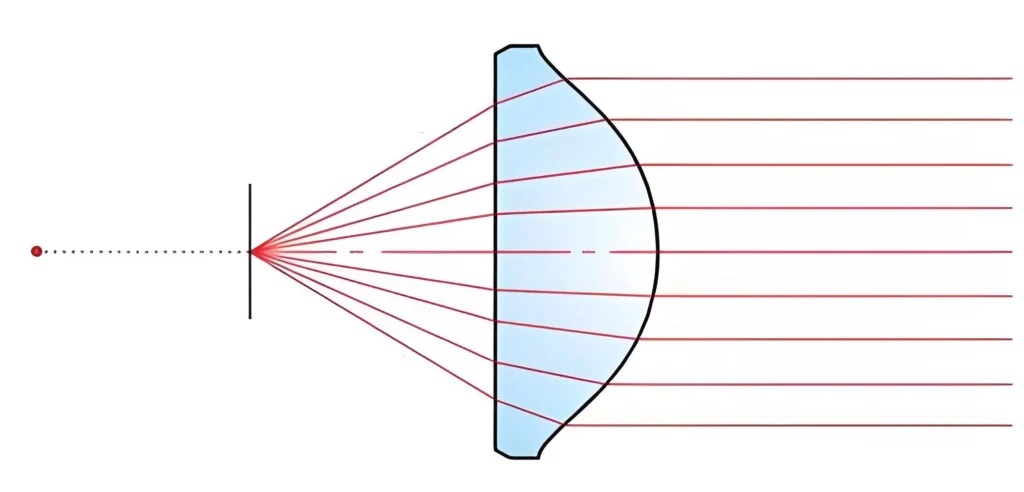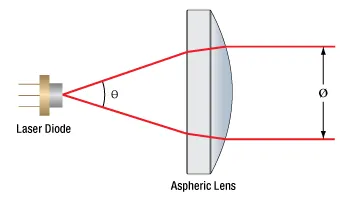Introduction
Collimating lenses are essential components in various optical systems, playing a crucial role in aligning and directing light beams. These lenses are designed to take diverging or converging light rays and transform them into parallel rays, which is vital for enhancing the performance of optical devices. Whether you’re working with lasers, fiber optics, or imaging systems, understanding collimating lenses and their applications is key to achieving optimal results. In this comprehensive guide, we’ll delve into what collimating lenses are, the different types available, their material composition, how they function, and the various configurations and applications in which they are used.

What Is a Collimating Lens?
A collimating lens is an optical component that is used to make light rays parallel. When light passes through a collimating lens, it transforms from a divergent or convergent beam into a parallel one. This parallel alignment of light is critical in many optical systems where precise direction and focus of light are required. Collimating lenses are often used in laser systems to ensure the laser beam remains focused over long distances, in fiber optics to align light for efficient transmission, and in imaging systems to enhance the clarity and accuracy of the image.
The fundamental principle behind a collimating lens is its ability to control the phase and direction of light waves. By carefully designing the curvature and material of the lens, it can manipulate light in such a way that all rays emerge in the same direction, effectively reducing or eliminating beam divergence.
Types of Collimating Lenses
Collimating lenses come in various types, each designed for specific applications and performance requirements. The two most common types are aspheric collimating lenses and spherical collimating lenses.

Aspheric Collimating Lenses are designed with a non-spherical surface profile that reduces spherical aberrations. This design allows for a more accurate collimation of light, making them ideal for high-precision applications such as laser systems and imaging devices. Aspheric lenses provide better performance in terms of focus and beam quality compared to spherical lenses, particularly in systems where maintaining beam uniformity is critical.
Spherical Collimating Lenses, on the other hand, have a simple spherical surface and are often used in less demanding applications where the slight aberrations they introduce are not critical. These lenses are generally easier and less expensive to manufacture, making them suitable for applications where cost is a more significant concern than precision.
What Materials Are Commonly Used for Collimating Lenses?
Collimating lenses are made from various materials, each chosen based on the specific optical properties required for the application. The most common materials include glass, plastic, and quartz.
Glass is the most widely used material for collimating lenses due to its excellent optical clarity and durability. Different types of glass, such as BK7 and fused silica, are selected based on their refractive indices, transmission properties, and resistance to thermal and mechanical stress.
Plastic lenses are often used in applications where weight and cost are significant factors. While they may not offer the same level of optical performance as glass, advancements in plastic molding technology have allowed for the production of high-quality aspheric collimating lenses that are suitable for many consumer electronics and low-cost optical systems.
Quartz is chosen for its high resistance to temperature fluctuations and its ability to transmit ultraviolet (UV) light. Quartz collimating lenses are commonly used in UV laser systems and other applications requiring stable performance under extreme conditions.
What Does a Collimating Lens Do?
The primary function of a collimating lens is to take light from a point source, such as a laser diode or an LED, and transform it into a parallel beam. This collimation process is crucial in various optical systems, as it ensures that the light can travel long distances without diverging, maintaining the beam’s intensity and focus.
In laser systems, collimating lenses are used to produce a coherent and focused beam that can be directed over large distances with minimal spread. In fiber optics, these lenses are used to couple light efficiently into the fiber, ensuring that the light travels through the fiber with minimal loss and distortion. In imaging systems, collimating lenses improve the clarity and sharpness of images by ensuring that the light entering the imaging sensor is parallel, thus reducing image distortions.
Collimating Lens Configuration
The configuration of a collimating lens within an optical system depends on the specific requirements of the application. The lens must be precisely aligned with the light source to achieve optimal collimation. In many cases, adjustable mounts are used to fine-tune the position and angle of the lens relative to the light source, allowing for precise control over the beam’s direction and focus.
In more complex optical systems, multiple collimating lenses may be used in conjunction to achieve the desired beam characteristics. For example, a system might use an initial collimating lens to create a parallel beam, which is then passed through additional optical components, such as filters or mirrors, before being re-collimated to adjust the beam’s properties.
How Collimating Lenses Are Produced
The production of collimating lenses is a meticulous process involving several critical stages: lens fabrication, inspection, coating application, assembly, and testing. Although the overall manufacturing process remains consistent across different types of collimating lenses, the specific application of the lens can influence certain aspects, such as testing methods, material selection, and coating design. Collimating lenses can be customized and manufactured to meet the precise requirements of various applications.
At Chineselens Optics, we specialize in the design and production of both custom and pre-engineered collimating lenses tailored to meet the unique needs of our clients. For straightforward projects such as laser collimators and beam expanders that require quick turnaround times, we offer a variety of standard collimating lenses. These lenses are available in different diameters, focal lengths, coatings, and mounting sizes. We provide coating options for various wavelengths, including 405 nm, 543 nm, 633 nm, 780 nm, 1064 nm, 1310 nm, 1550 nm, and 2000 nm, among others.
For clients seeking a more specialized solution, we also offer custom collimating lens design and consulting services. Our team at Chineselens Optics is ready to assist you in creating the perfect lens for your specific application needs. Please reach out to our sales team for further information.
The production process begins with the careful selection of materials based on the desired optical properties, such as refractive index, transmission range, and resistance to environmental conditions. The chosen material is then shaped using precision grinding and polishing techniques. This step is particularly intricate for aspheric lenses, which require advanced computer-controlled machinery to achieve the precise surface profile necessary to minimize optical aberrations.
Following the shaping process, the lens is treated with various optical coatings to enhance its performance. These coatings might include anti-reflective layers to reduce surface reflections, UV coatings to protect against ultraviolet light, and protective coatings to enhance the lens’s durability.
Collimating Lens Applications
Collimating lenses are used in a wide range of applications across various industries. Some of the most common applications include:
Laser Systems: Collimating lenses are essential in laser systems for creating focused and directed beams. They are used in everything from laser pointers to industrial cutting lasers, where precise beam control is necessary.
Fiber Optics: In fiber optic communication, collimating lenses are used to couple light into and out of optical fibers, ensuring efficient transmission with minimal loss.
Imaging Systems: Collimating lenses improve image quality in cameras, microscopes, and telescopes by ensuring that the light entering the imaging sensor is parallel, reducing distortions and enhancing clarity.
Spectroscopy: In spectroscopy, collimating lenses are used to direct light into a spectrometer, where it is dispersed into its component wavelengths for analysis.
Benefits of Using Collimating Lenses
The use of collimating lenses offers several benefits, including:
Enhanced Optical Performance: By creating parallel beams of light, collimating lenses improve the precision and accuracy of optical systems, resulting in better overall performance.
Increased Beam Control: Collimating lenses allow for precise control over the direction and focus of light, making them ideal for applications requiring high accuracy.
Versatility: Collimating lenses can be used in a wide variety of applications, from simple consumer electronics to complex industrial systems, making them a versatile choice for many optical designs.
In Summary
Collimating lenses are a critical component in modern optical systems, offering the ability to control and direct light with precision. Understanding the different types of collimating lenses, their materials, and their applications can help you select the right lens for your specific needs. Whether you’re working with lasers, fiber optics, or imaging systems, the use of collimating lenses can significantly enhance the performance and accuracy of your optical devices.

